
Top Ten Best Things to See in Museums in Washington, D.C.

1. Star-Spangled Banner
The Star-Spangled Banner is the flag that inspired the national anthem of the United States and is indisputably the greatest treasure on display at the Smithsonian Institution. The flag, originally 30 by 42 feet, flew over Fort McHenry in Baltimore. On September 13, 1814, during the War of 1812, a British fleet bombarded the fort. Francis Scott Key, a lawyer from Washington, D.C., witnessed the action as a prisoner on a nearby British ship. The following morning, Key was exultant to see the flag flying over the fort and wrote a poem, The Star-Spangled Banner, celebrating the victory. The poem was widely published and soon set to the tune of an English song, Anacreon in Heaven. The song's popularity grew over the following decades, but it didn't become the official national anthem until 1931.
After the battle, George Armistead, the fort's commander, kept the flag. It passed down through his family until they gave it to the Smithsonian Institution in 1912. In the meantime, about one third of the flag was clipped off for souvenirs, a common practice at the time. Today, the flag rests nearly flat in a special case at the American History museum on the Mall. The adjacent display has fragments of the bombs that burst in the air at Fort McHenry and an example of one of the rockets that gave off a red glare. The latter was lent by a museum in Great Britain, now a friend of the United States.
Location: National Museum of American History
Address: 1400 Constitution Avenue, N.W., Washington D.C.
Metro: Smithsonian or Federal Triangle
Photograph: National Museum of American History
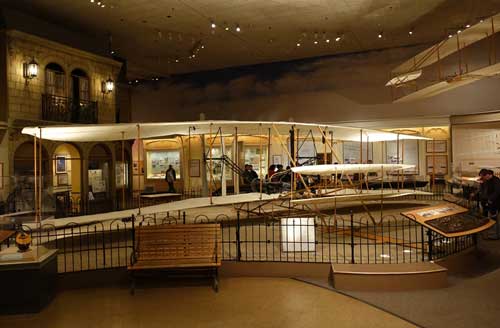
2. Wright Brothers' Flyer
This is the first airplane in the history of the world. It was built by brothers Wilbur and Orville Wright and flew four times on December 17, 1903, the first sustained flights by a heavier-than-air craft. Shortly after the fourth flight, a gust of wind flipped the plane over, damaging it, and it never flew again. It is now on display at the Smithsonian Air and Space Museum on the National Mall. Much of it is original, other than the propellor, some of the engine parts, and the fabric covering, which dates from a 1985 restoration. It can be seen on the second floor of the museum in a room dedicated to the plane and the remarkable story of the Wright Brothers. The exhibit is comprehensive, well-done, and attractive, and does justice to the two bicycle mechanics from Dayton who not only designed and built the world's first airplane, but established the basics of aeronautics as well.
Location: National Air and Space Museum
Address: 600 Independence Avenue, S.W. Washington, D.C.
Metro: L'Enfant Plaza
Photograph: © Peter R. Penczer 2015
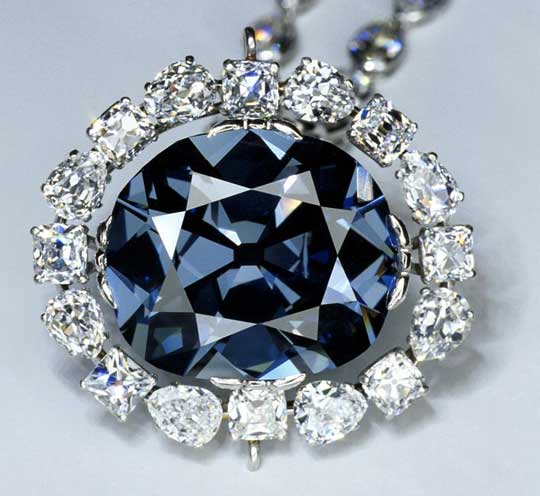
The Hope Diamond
3. Hope Diamond
The Hope Diamond is the most famous exhibit at the National Museum of Natural History and the star of the Hall of Geology, Gems, and Minerals. It is a deep-blue 45.52-caret stone, mounted in a ring of 16 white diamonds with a neck chain of 45 white diamonds. Its estimated value is $250 million! The gem has a long history--it emerged from India in the 17th century and was owned by King Louis XIV and Marie Antoinette of France. It derives its name from a later owner, Henry Philip Hope, a London banker and gem collector who died in 1839.
The diamond is notorious for a curse that is said to have followed it through the centuries. Marie Antoinette went to the guillotine; Evalyn Walsh McLean, a Washington heiress and socialite who bought the stone in 1911, saw her young son run over by a car and her husband go insane. However, Harry Winston, who bought the Hope diamond from her estate and later gave it to the Smithsonian, lived to a ripe old age. Nor has any terrible fate befallen the Smithsonian, which has owned the gem since 1958. While you are in the Hall of Gems, be sure to see the other gems and minerals, many of which are more spectacular in appearance than the famous Hope diamond.
Location: National Museum of Natural History
Address: 10th Street and Constitution Ave., N.W., Washington, D.C.
Metro: Federal Triangle, Smithsonian, or Archives
Photograph: Chip Clark, Smithsonian Institution Photo ID 97-35264
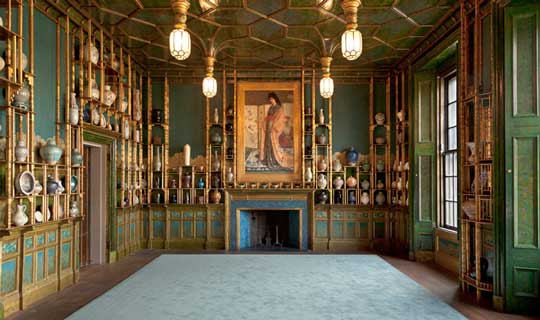
The Peacock Room at the Freer Gallery of Art
4. Peacock Room
The Peacock Room, lavishly painted in blue and gold by the American artist James McNeill Whistler, is undoubtedly the best known and most popular exhibit at the Freer Gallery of Art. The room was originally in the London home of Frederick R. Leyland, where he displayed his collection of blue and white porcelain. Leyland hired Whistler to decorate the room to harmonize with his painting The Princess from the Land of Porcelain. While Leyland went off on a long trip, the American painter pulled out all the stops, then presented Leyland with a huge bill. The latter refused to pay, precipitating a fight that is represented in the room by a painting of two golden peacocks locked in combat.
In 1904, the American collector Charles Lang Freer bought the room and installed it in his mansion in Detroit. Since 1923, it has been in the Freer Gallery of Art in Washington. Normally the shutters are closed, but every third Thursday afternoon of the month, the museum opens them to flood the room with natural light.
Location: Freer Gallery of Art
Address: Jefferson Drive and 12th Street, S.W., Washington, D.C.
Metro: Smithsonian
Photograph: Neil Greentree
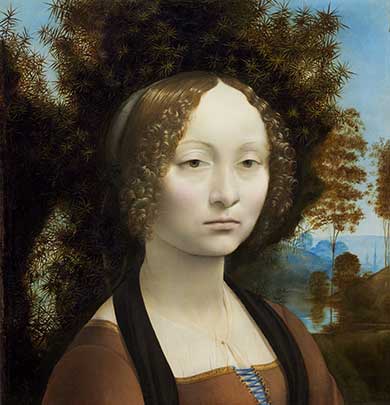
Leonardo da Vinci, Ginevra de' Benci, c. 1474/1478.
5. Ginevra de' Benci
It would be impossible to pick out one painting at the National Gallery of Art as the best, but Ginevra de' Benci is noteworthy as the only painting by Leonardo da Vinci in the Western Hemisphere. It was bought by the gallery in 1967 from the Prince of Liechtenstein for $5 million, the highest price ever paid for a work of art up to that time. There are only about 15 surviving paintings by the master in the world today.
Leonardo painted Ginevra de Benci when she was about 16 years old, perhaps at the time of her engagement. Whether her look is one of worldly detachment, or she is simply a bored teenager, it's up to the visitor to decide. The delicate shading in her face, which gives her a striking three-dimensional appearance, was "revolutionary in the history of painting," in the words of the National Gallery. Her pose-a three-quarters view-and her placement out of doors were both innovative as well.
Location: National Gallery of Art
Address: Constitution Avenue and Sixth Street, N.W., Washington, D.C.
Metro: Archives or Smithsonian
Photograph: Courtesy National Gallery of Art, Washington

6. The First Ladies
This exhibit features dresses from First Ladies of the United States: presidents' wives or, for unmarried presidents, female relatives who served as hostesses at the White House. The Smithsonian owns a dress from every First Lady, but only a selection is on display since the museum discovered that some of the dresses had been damaged by light.
This exhibit first opened in 1914 and it has been one of the most popular at the Smithsonian ever since. That may be because the empty gowns, hanging on their forms, evoke in some mysterious way the physical presence of these famous women. On a more prosaic level, the gowns remind us of changing fashions and tastes, and visitors will learn about the evolving roles and wide-ranging interests of the presidents' wives.
Location: National Museum of American History
Address: 1400 Constitution Avenue, N.W., Washington, D.C.
Metro: Smithsonian or Federal Triangle
Photograph: Smithsonian Institution
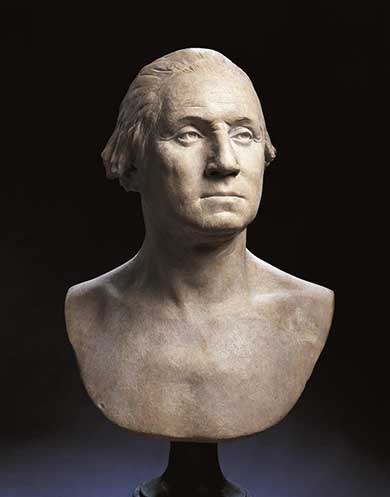
George Washington by Jean Antoine Houdon
7. Bust of George Washington
This bust of George Washington is one of the great treasures of American history. It was made from life by the French sculptor Jean Antoine Houdon and was said by Washington's relatives to be the best likeness of the first president. Houdon traveled from Paris to Mount Vernon in 1785 and spent two weeks with Washington observing him, commissioned by Benjamin Franklin and Thomas Jefferson. Houdon made a plaster life mask of the president and left this clay bust at Mount Vernon when he returned to France. It is one of the few artifacts that have remained at Mount Vernon since Washington died in 1799.
If you want to know what Washington looked like, you should see this bust. It is on display in the entrance to the museum at Mount Vernon. Admission includes a tour of Washington's mansion, free run of the grounds including the tomb, the museum, an education center, and several films.
Location: George Washington's Mount Vernon
Address: 3200 Mount Vernon Memorial Highway Mount Vernon, Va.
Metro: The best way to reach Mount Vernon is by car--there is plenty of free parking. It is also possible to travel there from Washington or Alexandria by boat. Metrorail and bus (or a cab) is another possibility--details are on the Mount Vernon website.
Website: mountvernon.org
Photograph: Mount Vernon Ladies' Association
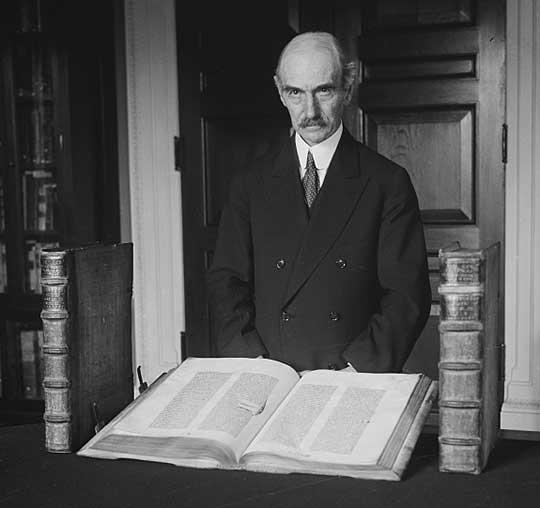
Herbert Putnam, librarian of Congress, in 1930 when the library acquired its copy of the Gutenberg Bible. The bible was bound in three volumes.
8. Gutenberg Bible
Dating from 1455, this bible is, for all practical purposes, the world's first printed book. Johannes Gutenberg invented the process of printing with movable type, in which individual letters are locked into a case and used to print an entire page (or several pages) at a time. Previously, books had to be copied by hand, and it could take two men a year to make a single copy of the bible. Gutenberg's invention made books widely available across Europe, an information explosion akin to the invention of the Internet. Easier access to information made the Reformation and the Renaissance possible.
Gutenberg printed about 180 of these bibles, but only 21 survived into the 20th century intact. This is one of only three complete copies printed on vellum (animal skin) in the world. Moreover, it is a great example of the printer's art. The text is in Latin, a translation made by St. Jerome at the end of the fourth century, A.D. The bible is on display in the public area of the Jefferson Building at the Library of Congress. Enter at the top of the stairs on First Street, S.E.
Location: Library of Congress
Address: 10 First Street, S.E., Washington, D.C.
Metro: Capitol South
Photograph: Library of Congress
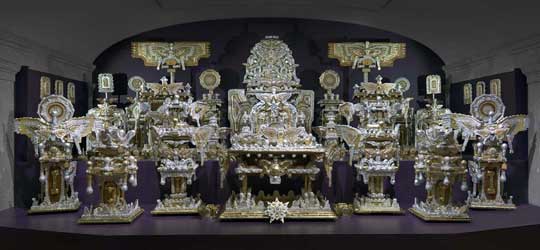
The Throne was the masterpiece of James Hampton. It was discovered after his death in 1964.
9. The Throne of the Third Heaven of the Nations' Millennium General Assembly
Inspired by religious visions, James Hampton created The Throne, his life's work, in a rented garage in Washington, D.C. It's constructed of cardboard, bits of foil, and discarded furniture and lightbulbs, some of which Hampton found on the job as a janitor for the federal government. In the center is a throne, flanked on two levels by the New Testament (on the left) and the Old Testament (right). According to scripture, the Third Heaven is the part of heaven where God dwells.
Hampton was described as a recluse, and the work was not discovered until after his death in 1964. He had no training in art and was guided by his own innate artistic sense. As such, his Throne is widely considered the preeminent work of folk, or visionary, art in the United States. It is on display at the Smithsonian American Art Museum, in downtown Washington about four blocks north of the National Mall.
Location: Smithsonian American Art Museum
Address: North Entrance: G and 8th streets, N.W.; South Entrance: F and 8th streets, N.W.
Metro: Gallery Place, Metro Center
Photograph: James Hampton, The Throne of the Third Heaven of the Nations' Millennium General Assembly, ca. 1950-1964, mixed media, Smithsonian American Art Museum, Gift of anonymous donors, 1970.353.1-.116

Luncheon of the Boating Party, by Pierre-Auguste Renoir
10. Luncheon of the Boating Party
The best collection of Impressionist paintings in Washington, D.C., is tucked away on a side street near Dupont Circle, at the Phillips Collection. Opened in 1921, the Phillips describes itself as "America's first museum of modern art." Museum founder Duncan Phillips bought Luncheon of the Boating Party, by Pierre-Auguste Renoir, to serve as the foundation and centerpiece of the collection, and it remains so today.
Many consider Renoir's painting, completed in 1881, to be the greatest masterpiece in the city. It depicts a lunch at the Maison Fournaise, a restaurant by the Seine, near Paris. The models are friends and associates of Renoir's, and the woman on the left later became his wife. It's a brief moment of youth and beauty that seems to last forever. Nevertheless, the scene was probably never a real event, and recent research shows that Renoir heavily reworked the canvas as it progressed.
Location: Phillips Collection
Address: 1600 21st Street, N.W., Washington, D.C.
Metro: Dupont Circle
Photograph: Pierre-Auguste Renoir, Luncheon of the Boating Party, 1880-81. Oil on canvas, 51 1/4 x 69 1/8 in. The Phillips Collection, Washington, D.C., Acquired 1923
Copyright © Peter R. Penczer 2018